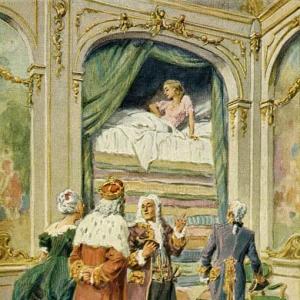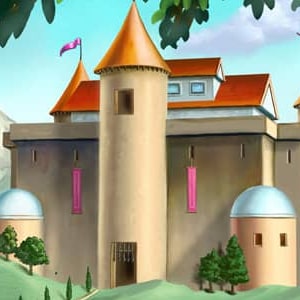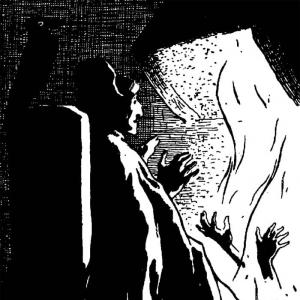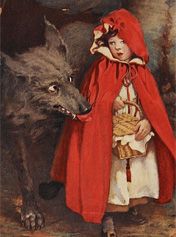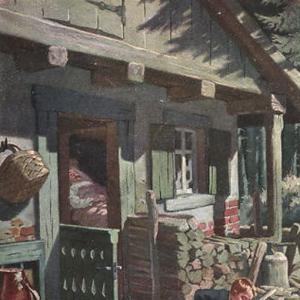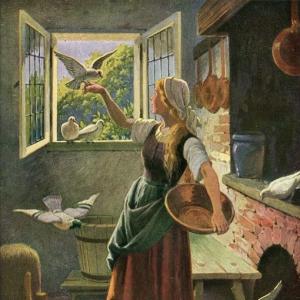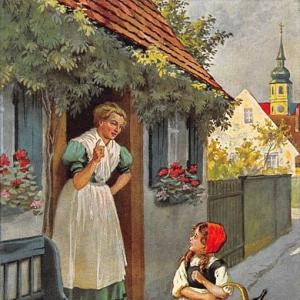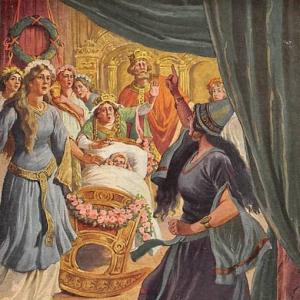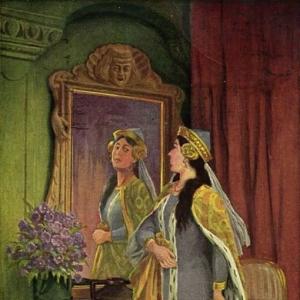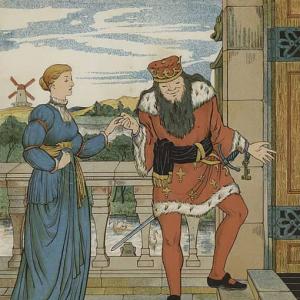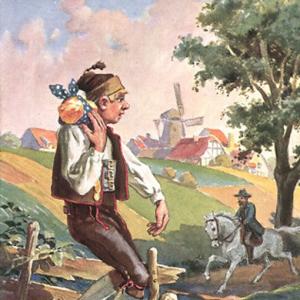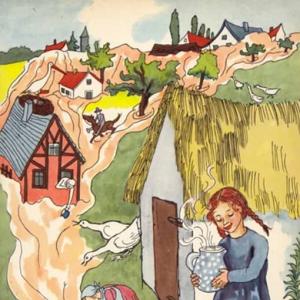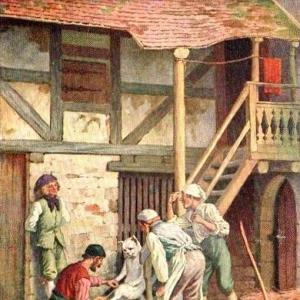Reading time: 4 min
„Good-day, Father Hollenthe.“ – „Many thanks, Pif-paf-poltrie.“ – „May I be allowed to have your daughter?“ – „Oh, yes, if Mother Malcho (Milch-cow), Brother High-and-Mighty, Sister K“setraut, and fair Katrinelje are willing, you can have her.“
„Where is Mother Malcho, then?“ – „She is in the cow-house, milking the cow.“
„Good-day, Mother Malcho.“ – „Many thanks, Pif-paf-poltrie.“ – „May I be allowed to have your daughter?“ – „Oh, yes, if Father Hollenthe, Brother High-and-Mighty, Sister K“setraut, and fair Katrinelje are willing, you can have her.“ – „Where is Brother High-and-Mighty, then?“ – „He is in the room chopping some wood.“ – „Good-day, Brother High-and-Mighty.“ – „Many thanks, Pif-paf-poltrie.“ – „May I be allowed to have your sister?“ – „Oh, yes, if Father Hollenthe, Mother Malcho, Sister K“setraut, and fair Katrinelje are willing, you can have her.“ – „Where is Sister K“setraut, then?“ – „She is in the garden cutting cabbages.“ – „Good-day, sister K“setraut.“ – „Many thanks, Pif-paf-poltrie.“ – „May I be allowed to have your sister?“ – „Oh, yes, if Father Hollenthe, Mother Malcho, Brother High-and-Mighty, and fair Katrinelje are willing, you may have her.“ – „Where is fair Katrinelje, then?“ – „She is in the room counting out her farthings.“ – „Good day, fair Katrinelje.“ – „Many thanks, Pif-paf-poltrie.“ – „Wilt thou be my bride?“ – „Oh, yes, if Father Hollenthe, Mother Malcho, Brother High-and-Mighty, and Sister K“setraut are willing, I am ready.“
„Fair Katrinelje, how much dowry do hast thou?“ – „Fourteen farthings in ready money, three and a half groschen owing to me, half a pound of dried apples, a handful of fried bread, and a handful of spices.
And many other things are mine,
Have I not a dowry fine? „Pif-paf-poltrie, what is thy trade? Art thou a tailor?“ – „Something better.“ – „A shoemaker?“ – „Something better.“ – „A husbandman?“ – „Something better.“ – „A joiner?“ – „Something better.“ – „A smith?“ – „Something better.“ – „A miller?“ – „Something better.“ – „Perhaps a broom-maker?“ – „Yes, that’s what I am, is it not a fine trade?“
 Learn languages. Double-tap on a word.Learn languages in context with Childstories.org and Deepl.com.
Learn languages. Double-tap on a word.Learn languages in context with Childstories.org and Deepl.com.Backgrounds
Interpretations
Adaptions
Summary
Linguistics
„Fair Katrinelje and Pif-Paf-Poltrie“ is a lesser-known fairy tale collected by the Brothers Grimm, Jacob and Wilhelm, in their anthology of German folktales, „Kinder- und Hausmärchen“ (Children’s and Household Tales), first published in 1812. The Brothers Grimm were German academics, linguists, and cultural researchers who collected and published numerous fairy tales and legends in their lifetime, many of which have become famous worldwide.
Jacob (1785-1863) and Wilhelm (1786-1859) Grimm were born in Hanau, Germany, and spent most of their lives together as scholars and researchers. They were part of the Romanticism movement, which was characterized by a renewed interest in folklore, mythology, and traditional culture. Their work aimed to preserve the oral traditions and stories that were being lost due to the rapid social and cultural changes of their time.
The tales collected by the Brothers Grimm encompass a wide range of genres, from dark and haunting stories to light-hearted and humorous tales like „Fair Katrinelje and Pif-Paf-Poltrie.“ Their fairy tales have had a lasting impact on Western literature and culture, influencing authors, filmmakers, and artists for generations.
In „Fair Katrinelje and Pif-Paf-Poltrie,“ the repetitive narrative structure and humorous tone differentiate it from some of the more well-known Grimm fairy tales. This story is an example of the brothers‘ dedication to capturing the diversity of German folklore and the various themes and values that were present in their society at the time.
„Fair Katrinelje and Pif-Paf-Poltrie“ can be interpreted in various ways, highlighting different aspects of social values, relationships, and the human experience:
Importance of family consent: The story emphasizes the significance of obtaining the approval of all family members before getting married. This theme reflects the value placed on family harmony and unity in traditional societies, where marriage was considered not just a union between two individuals but also a bond between two families.
Marriage and social expectations: The tale showcases the importance of dowries and trades in determining a suitable match for marriage. The characters assess their compatibility based on their financial status and professions. This reflects societal expectations and norms in historical times when marriages were often driven by economic and social considerations rather than personal affection.
Persistence and determination: Pif-Paf-Poltrie’s journey in seeking fair Katrinelje’s hand in marriage demonstrates the importance of persistence and determination. He approaches each family member one by one, never giving up until he has obtained everyone’s approval. This can be seen as a lesson in resilience and the value of pursuing one’s goals despite obstacles.
The role of communication: The story highlights the importance of clear communication between individuals and within families. Pif-Paf-Poltrie must engage in open conversations with each family member to gain their consent, emphasizing the necessity of understanding one another’s perspectives and desires.
Humor and simplicity: The fairy tale’s light-hearted tone and playful dialogues serve as a reminder of the importance of humor and simplicity in life. The characters‘ interactions and the repetitive structure of the story create an amusing atmosphere that encourages readers to enjoy the narrative for its entertainment value.
Overall, „Fair Katrinelje and Pif-Paf-Poltrie“ can be interpreted in various ways, offering valuable insights into family dynamics, marriage, and personal determination while also emphasizing the importance of communication, humor, and simplicity.
„Fair Katrinelje and Pif-Paf-Poltrie“ is a lesser-known fairy tale, and as such, there are not as many adaptations of this story compared to some of the other well-known Grimm tales. However, there are a few notable adaptations:
„The Three Tasks of Pif-Paf-Poltrie“: This is a children’s book written by Wilhelm Hauff in 1827 that is based on the same story as „Fair Katrinelje and Pif-Paf-Poltrie.“ The book tells the story of a poor peasant boy named Peter who performs three impossible tasks for a princess and wins her hand in marriage.
„Pif-Paf-Poltrie“: This is a short animated film created by the German animator Lotte Reiniger in 1936. The film is based on the same story as „Fair Katrinelje and Pif-Paf-Poltrie,“ and features Reiniger’s signature silhouette animation style.
„Pif-Paf-Poltrie and the Magic Bell“: This is a play for children written by German playwright Max Kruse in 1963. The play is based on the same story as „Fair Katrinelje and Pif-Paf-Poltrie,“ but introduces a magical bell that plays a key role in the story.
„The Third Gift“: This is a short story written by Patricia A. McKillip that is inspired by „Fair Katrinelje and Pif-Paf-Poltrie.“ The story follows a young woman named Katrin who must perform three impossible tasks to win the hand of a prince, but ultimately chooses to follow her own path instead.
Overall, while there are not as many adaptations of „Fair Katrinelje and Pif-Paf-Poltrie“ as there are of other Grimm tales, the story has inspired a few notable works in different mediums.
„Fair Katrinelje and Pif-Paf-Poltrie“ is a fairy tale by Brothers Grimm that follows the journey of Pif-Paf-Poltrie as he seeks to marry fair Katrinelje. In the story, Pif-Paf-Poltrie visits various family members to ask for their permission to marry fair Katrinelje, including Father Hollenthe, Mother Malcho, Brother High-and-Mighty, and Sister Käsetraut.
First, Pif-Paf-Poltrie meets Father Hollenthe and asks for his daughter’s hand. Father Hollenthe agrees, as long as the rest of the family is willing. Pif-Paf-Poltrie then visits Mother Malcho, who is in the cow-house milking the cow. She too consents if the rest of the family agrees. Next, he meets Brother High-and-Mighty, who is chopping wood in the room. He also consents, provided the other family members are willing.
Pif-Paf-Poltrie proceeds to Sister Käsetraut, who is in the garden cutting cabbages. She consents, as long as the rest of the family is willing. Finally, Pif-Paf-Poltrie meets fair Katrinelje in her room, where she is counting her farthings. She agrees to become his bride, provided that her family has granted their permission.
When Pif-Paf-Poltrie inquires about her dowry, Katrinelje replies that she has fourteen farthings in ready money, three and a half groschen owed to her, half a pound of dried apples, a handful of fried bread, and a handful of spices. As for Pif-Paf-Poltrie’s trade, he confirms that he is a broom-maker, which he considers a fine profession.
In this light-hearted tale, the importance of family consent in marriage is highlighted, as well as the significance of dowries and trades in determining the suitability of potential partners.
The fairy tale „Fair Katrinelje and Pif-Paf-Poltrie“ from the Brothers Grimm collection offers a rich ground for linguistic analysis, demonstrating various conversational structures and social conventions indicative of the time it was written.
Repetitive Structure: The tale employs a repetitive dialogue structure, a common feature in folklore, which serves multiple purposes:
–
Memory Aid: The repetition makes it easier for oral storytelling, enabling the teller to remember the sequence of events.
Rhythm and Predictability: It creates a rhythmic pattern that can be engaging for listeners and offers predictability in storytelling.
Formal Greetings: The dialogue exemplifies the use of formal greetings and gratitude:
– „Good-day, Father Hollenthe“: and „Many thanks, Pif-paf-poltrie“: indicate formal and polite conversational exchanges typical of traditional social interactions.
Indirect Speech Acts: The characters engage in indirect speech acts while seeking permission, reflecting societal norms and respect for hierarchical structures:
– Asking each family member’s permission acknowledges their roles and importance in the decision-making process, emphasizing the community’s collective voice.
Rhyme and Rhythm: The mix of dialogue and rhymed verse enhances the lyrical quality of the text:
– „Have I not a dowry fine?“: incorporates rhyme, adding a musicality to the narrative.
Dowry and Social Roles: The discussion of dowry and professions reflects societal values and economic considerations:
– The dowry scene outlines what is considered valuable, while the question about Pif-paf-poltrie’s trade reveals societal occupation hierarchies. Professions are initially deemed „something better“ until the revealing of broom-making, humorously deflating expectations.
Childlike Nonsense Naming: Names like „Pif-Paf-Poltrie“ and „Father Hollenthe“ contribute to the tale’s whimsical tone:
– Such names may not have direct translations or meanings, adding to the fantastical and nonsensical atmosphere characteristic of fairy tales.
Symbolism and Metaphor: The characters and their actions can symbolize broader human interactions and societal norms:
– The metaphorical ‚counting of farthings‘ can indicate a focus on wealth and material preparedness for marriage, common in tales reflecting societal norms.
Overall, the tale uses linguistic elements to emphasize cultural values, societal structures, and the art of storytelling itself, encapsulating the whimsical yet structured nature of fairy tales in the Brothers Grimm’s time.
Information for scientific analysis
Fairy tale statistics | Value |
|---|---|
| Number | KHM 131 |
| Aarne-Thompson-Uther-Index | ATU Typ 2019 |
| Translations | DE, EN, DA, ES, PT, IT, JA, NL, PL, RU, TR, VI, ZH |
| Readability Index by Björnsson | 25.3 |
| Flesch-Reading-Ease Index | 77.5 |
| Flesch–Kincaid Grade-Level | 4.3 |
| Gunning Fog Index | 4.5 |
| Coleman–Liau Index | 9.8 |
| SMOG Index | 7.5 |
| Automated Readability Index | 2.8 |
| Character Count | 2.110 |
| Letter Count | 1.484 |
| Sentence Count | 46 |
| Word Count | 341 |
| Average Words per Sentence | 7,41 |
| Words with more than 6 letters | 61 |
| Percentage of long words | 17.9% |
| Number of Syllables | 491 |
| Average Syllables per Word | 1,44 |
| Words with three Syllables | 25 |
| Percentage Words with three Syllables | 7.3% |

 Facebook
Facebook  Whatsapp
Whatsapp  Messenger
Messenger  Telegram
Telegram Reddit
Reddit